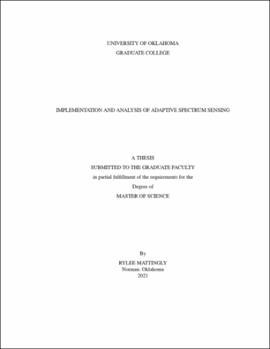| dc.contributor.advisor | Metcalf, Justin | |
| dc.contributor.author | Mattingly, Rylee | |
| dc.date.accessioned | 2021-08-04T14:03:44Z | |
| dc.date.available | 2021-08-04T14:03:44Z | |
| dc.date.issued | 2021-08-05 | |
| dc.identifier.uri | https://hdl.handle.net/11244/330198 | |
| dc.description.abstract | The electromagnetic spectrum is a finite resource that has become increasingly crowded as the day-to-day operation of the world has become increasingly reliant on wireless devices. With the growing deployment of the Internet-of-Things (IoT), 5G Networks, and broadband internet systems, the available spectrum for radar applications has been reduced and instances of interference across all device types have increased. To mitigate this problem going forward, devices need to be better able to intelligently access the spectrum based on the presence of other users.
A cognitive radio or radar system functions by using adaptive spectrum sensing to detect existing users in the frequency band and adapt to use ’open’ spectrum bands. To ensure the predictable performance of the system and systems that it shares spectrum with, it must detect new users and adapt without interrupting its operation or interfering with the other users. Because modern communications networks can update their spectrum utilization on a sub-millisecond timescale, the critical detection and adaption phase must operate in real-time.
This work presents an implementation of a fast spectrum sensing (FSS) algo- rithm deployed on the field-programmable gate array (FPGA) of an Ettus USRP software-defined radio. This implementation allows for microsecond scale updates of the environment’s spectrum availability. Unfortunately, this FSS algorithm is limited by its knowledge of the spectrum, which is ever-changing. To help improve the system’s dynamic performance a new adaptive detection algorithm is proposed to replace the static threshold of the first implementation. The new detection algo- rithm is a constant false alarm rate (CFAR) inspired detector which allows a cogni- tive sensor to work in a dynamic environment without a-priori information about the spectrum. Combining the FSS algorithm with dynamic signal detection allows the cognitive radio system to adapt to the ever-changing environment without requiring extensive ’listen before talk’ periods before operation. | en_US |
| dc.language | en_US | en_US |
| dc.rights | Attribution-NonCommercial-NoDerivatives 4.0 International | * |
| dc.rights.uri | https://creativecommons.org/licenses/by-nc-nd/4.0/ | * |
| dc.subject | Spectrum Sensing | en_US |
| dc.subject | Hardware Acceleration | en_US |
| dc.subject | FPGA | en_US |
| dc.subject | Spectrum Management | en_US |
| dc.subject | RF Network-on-Chip | en_US |
| dc.subject | RFNoC | en_US |
| dc.subject | USRP | en_US |
| dc.title | Implementation and Analysis of Adaptive Spectrum Sensing | en_US |
| dc.contributor.committeeMember | Goodman, Nathan | |
| dc.contributor.committeeMember | Fitzmorris, Cliff | |
| dc.date.manuscript | 2021-07 | |
| dc.thesis.degree | Master of Science | en_US |
| ou.group | Gallogly College of Engineering::School of Electrical and Computer Engineering | en_US |
| shareok.orcid | 0000-0002-5865-4504 | en_US |
| shareok.nativefileaccess | restricted | en_US |

